Everything You Always Wanted to Know About a Flight to the Moon
Compton Encyclopedia’s Teaching Unit on Aerospace and Space Travel
Exploring the intersection of spaceflight history, pop culture, and space art.
This edition of Creating Space presents a two-in-one treat for young Space Geeks everywhere. A Teaching Unit on Aerospace and Space Travel from the publishers of Compton’s Pictured Encyclopedia is both an educational reference for spaceflight and a colorful and engaging wall poster any 1960s kid would have loved to have hanging on their bedroom wall.
Are you new to Creating Space? It’s the NERDSletter that explores the intersection of spaceflight history, pop culture, and space art. You can find this and all other posts at creating-space.art.
A Teaching Unit on Aerospace and Space Travel from Compton's Pictured Encyclopedia
When I was growing up, our family had a set of World Book encyclopedias. It consisted of about two-dozen red inch-thick volumes. The ‘A’ and ‘S’ volumes were the ones I opened the most. To be more precise, our set was more finely divided. In the ‘A-Ale’ volume, I would read about Airplanes. ‘Ari-Azu’ is where I would learn about Astronomy. At the other end of the shelf, ‘S-Snu’ contained the ringed planet, Saturn, and ‘Soa-Szi’ revealed all the mysteries of Space. That’s right – I was one of the nerds that read the encyclopedia for fun. That early research would form much of the blueprint for the rest of my life.
As much as I enjoyed World Book’s encyclopedia, I recently discovered something that might have even more completely captured my imagination. Presented here for your consideration is a beautiful and comprehensive Teaching Unit on Aerospace and Space Travel from the publishers of Compton’s Pictured Encyclopedia, ca. 1963.
Had I not become an aerospace engineer, I might have chosen to pursue a career as an astronaut or work in astronomy. (As it turns out, I was too tall for the former, and an aversion to working nights ruled out the latter.) This teaching guide was aimed at educators with aspiring astronauts and space mission designers in their classrooms.
Covering Apollo
There are two things that attracted me to this teaching guide when I saw it on an auction website. The first was the image on the front cover. The second thing that caught my eye was the elaborately illustrated fold-out poster inside. More about that in a moment.
The cover page illustration depicts a student overlooking the Moon, around which orbits a very early pair of Apollo spacecraft. I love the striking way the Moon is illustrated. The bright yellow rays of the Sun shine a stark rim light over the lunar horizon. Crisply defined crater walls cast long spikes of shadows over the blue-tinted darker side of the Moon. Hand-painted illustrations of this era were particularly eye-catching, and used to great effect for younger audiences.
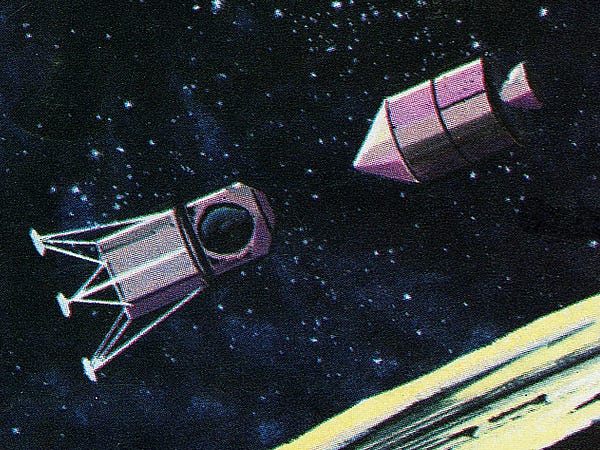
The two spacecraft represent the 1962 Lunar Orbit Rendezvous (LOR) proposal configuration for Apollo – the first of many design iterations. Regular readers of Creating Space, and those that know me personally, are aware of my fascination with the Lunar Module’s (LEM) design evolution. To me, finding physical media that includes such an early representation of the LEM is almost akin to finding an original draft of Kennedy’s “We choose to go to the Moon” speech. This is a rare example of how the nascent Moon program was being introduced to young readers to get them familiar with NASA’s bold plans.
Guidance is Internal
Opening the first of two folds of the guide reveals the teaching unit’s text and diagrams. The guide extensively covers two main topics – aerospace and space travel. According to the introductory text, “Travel through space is of high interest to children.” I can attest to this with first hand experience, having been a child once.
Each section of the three-page text portion of the guide gives a brief overview of a topic while referring the reader to specific articles within the main encyclopedia set for further research. Following this information is a list of suggested activities for teachers to use with their students in their classrooms, along with diagrams in some of the sections. Teachers could tailor the material for a variety of grade levels – from primary grades up through junior high school – by adapting the detailed information provided.
Sections include “The Expanse of Aerospace”, “Space Travel Timeline”, “Rockets”, “Satellites and Telemetry”, “Manned Space Travel”, “Space Station”, and “Flights to the Moon”.
Here are the diagrams that accompany the text.
This one is titled, How Rockets Work. Actually, the diagram does little to explain how they work, but instead gives an overview of the structural layout of solid-fueled missiles.

Next comes an interesting illustrated list of various types of satellites and their uses. I find it amusing that the term “moon” was used at that time to describe artificial satellites. Even the term “artificial” demonstrates how novel these orbiting workhorses were back then.
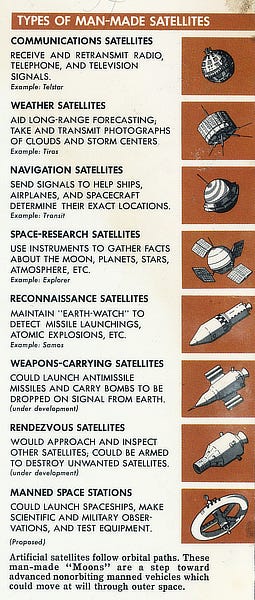
This “Simplified Satellite Telemetry System” does more than hint at how complex the collection of sensors and signal receiving and processing equipment really is. Perhaps there are some seasoned electrical engineers that first got interested in their field by studying diagrams like this one.
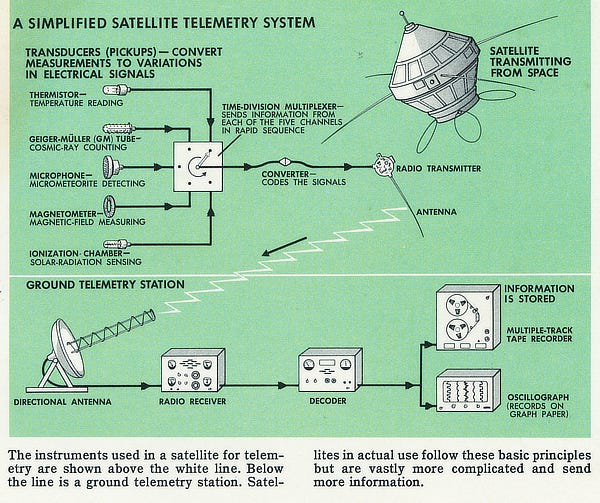
Charting Your Course to the Moon
I’ve saved the best for last. On the reverse side of the double-fold-out pamphlet is a beautifully illustrated poster diagramming a flight to the Moon. I love these old educational posters. This one does a wonderful job of combining in-depth educational content with eye-catching graphic design.
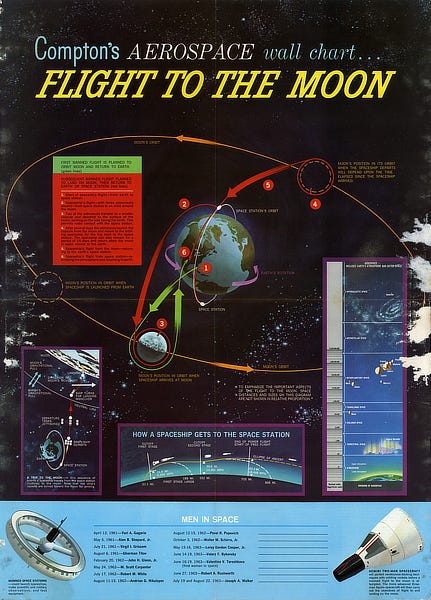
The centerpiece of the poster is an elaborately depicted Earth and Moon superimposed with a pretzel-twisting of numbered orbital paths. Song writer, Arlo Guthrie, would be impressed by all the circles and arrows and paragraphs on the back of this glossy document.1
The diagram presents two different lunar missions – a lunar fly-by trip and a lunar landing mission. The lunar fly-by trajectory shows, in green, a launch from Florida with a non-orbital swing around the far side and a direct return to a location somewhere in the southern United States. There will be no wimpy splashdowns for these intrepid explorers!
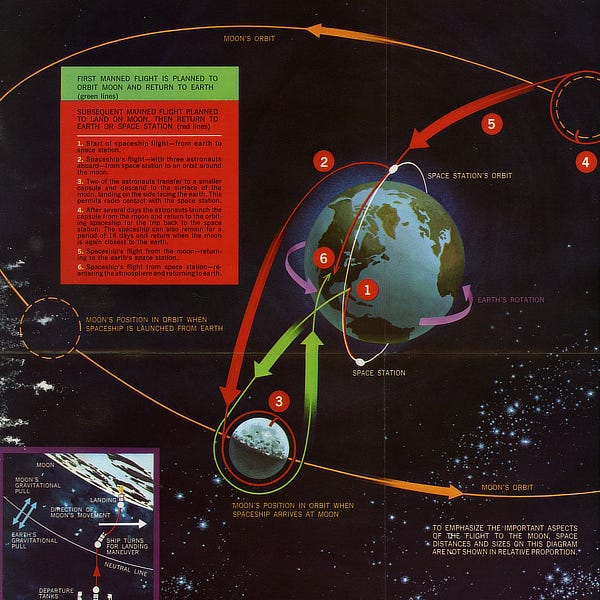
The lunar landing mission is presented with a stop at an orbiting space station. Early concepts for space missions often included stops at a space station. Some of those concepts suggested that that vehicles would be assembled in space, either inside or nearby the station, and fueled up to complete the remainder of the trip. The assumption being that those vehicles could be built exclusively for travel in space and thereby be made lighter and more efficient. They could also be built to be larger than anything that could be launched aboard any single rocket from Earth.
There are two interesting things I think are worth noting regarding the lunar landing scenario. First is the combination of a lunar orbit rendezvous (LOR) approach together with a stop at a space station. The Apollo lunar landing missions, as you know, launched a pair of spacecraft – a Command/Service Module and a Lunar Module – on a single rocket and flew non-stop to the Moon.
The second thing to note is the possibility of remaining near the Moon for fourteen days. Apollo lunar missions were designed to last up to two weeks in total from launch to splashdown. Given that it took about three days to traverse the distance between the Earth and Moon, each way, that would leave a maximum of eight days left for being near and on the Moon. The longest of the lunar landing missions – Apollo 17 – took twelve-and-a-half days in total.2 The time in the Moon’s vicinity was only 6 days. It is interesting to see on the poster the change in the Moon’s position in its orbit after 14 days. That is approximately half of its orbit. It honestly never occurred to me that the Moon made almost a half an orbit in the time of the entire Apollo 17 mission.
There are three additional diagrams inset within purple frames below the orbit drawing.
The first depicts, interestingly enough, a direct ascent type lunar landing scenario. Departing an Earth-orbiting space station is an early von Braun / Chesley Bonestell style Moonship. Midway between the Earth and Moon, empty fuel tanks are jettisoned. The remainder of the ship approaches the Moon and flips around for landing.
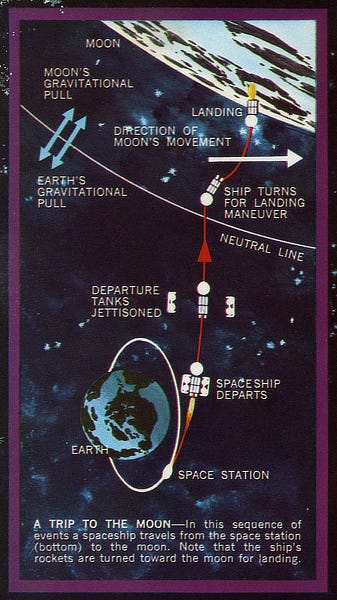
Here’s the von Braun moonship illustrated by Chesley Bonestell for comparison.
By the way – I wonder if the Direct Ascent drawing might have originally been drawn flipped with the Earth near the top and the Moon at the bottom. Looking at the Earth’s land masses, it appears to me that the north pole is near the bottom of the sphere, near the letter ‘H’ in ‘EARTH’.
The next inset, titled “How a Spaceship Gets to the Space Station”, illustrates what looks to be a Saturn V (or C-5, at that time) rocket traveling into Earth orbit. Altitudes, speeds, and downrange distances are called-out at various points. Engine cut-off points mark where the first and second stages are jettisoned.
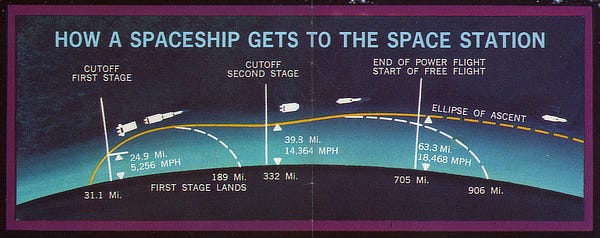
Where, you may ask, is the space station and how does our spaceship get to it? I guess learning about orbital mechanics and rendezvous are left to the enterprising reader.
The third and final inset is one similar, at first glance, to diagrams one might have seen in a number of science books about flight. I am referring to illustrations that identify the different regions of the atmosphere, such as Troposphere, Stratosphere, etc. This one, however, takes a giant step back and splits up the space above the atmosphere (here simplified into just upper and lower) into separate regions.

Starting from the bottom, using a log scale, the atmosphere meets “Terrestrial Space” at about 100 nautical miles (185 km) above the Earth’s surface. The Aurora Borealis is shown in this region. Then comes “Cis-Lunar Space” reaching the Moon. “Translunar Space” extends beyond the Moon to about one-million nautical miles (1.85 million km). “Interplanetary Space” is how far one would need to travel to reach the planets in our solar system. “Interstellar Space” – the distance to the stars in our galaxy. And, finally, “Intergalactic Space” – the distances to other galaxies.
Men in Space
On the bottom of the poster is a list of men who had flown in space, beginning with Yuri Gagarin on April 12, 1961 and ending with Joseph Walker’s flight on August 22, 1963.
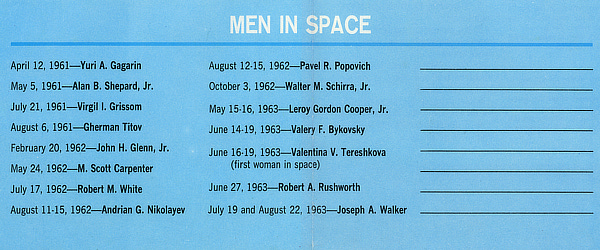
The Mercury astronauts are well-known names in the United States. Some readers may be familiar with the Soviet Union’s cosmonauts mentioned in the table.
Robert White, Robert Rushworth, and Joseph Walker may be less familiar names. They were among the twelve men who piloted the X-15 rocket research plane. The flights spanned from 1959 to 1968.3 The flight research program investigated both high speed and high altitude flight. The highest of the high altitude flights exceeded the 50 mile (80 km) mark, which was designated by the U.S. Air Force to be the minimum height to be considered as spaceflight. At the time, NASA used the Fédération Aéronautique Internationale (FAI) definition for the boundary of space, 100 km (62 miles). Eight of the X-15 pilots eventually earned their astronaut wings flying high altitude test flights.4 White, Rushworth, and Walker are included in the teaching guide’s chart for this reason.
Presumably, the blank lines on the right are spaces where you could write in up to eight of the next space travelers. I will leave that as an exercise for the ambitious Creating Space reader.
Art News
I am very happy to announce that I will once again be exhibiting my space-inspired artwork at the U.S. Astronaut Hall of Fame Induction weekend events this year in Cocoa Beach, Florida. I will be joining notable space artists Chris Calle, Lee Wilson, and astronaut/artist Nicole Stott.
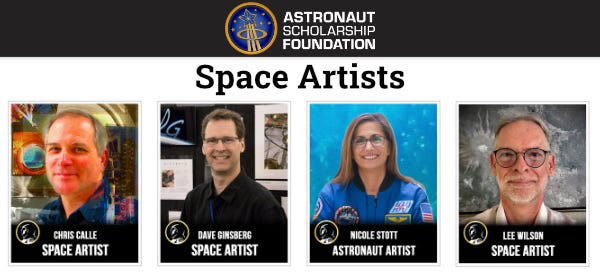
This year’s celebrations will be held from May 29 through 31, 2025. This will be my third time exhibiting at an ASF event.
The events are organized by the Astronaut Scholarship Foundation (ASF), a non-profit organization that provides scholarships to the brightest and most talented college students in science, technology, engineering and mathematics.5 I am proud to be able to support the ASF in their educational mission. A portion of my sales proceeds will go directly to the ASF organization.
Merch of the Month
Solar System Giclée Print
Plan your own trip to the Moon or the planets in our solar system with this high-quality wall art.
As a special thank-you for reading Creating Space, I am offering a discount on my artwork. Simply use code CREATINGSPACE15% for 15% off your entire order from the Pixel Planet Pictures shop.
My space-inspired art portfolio can be found at pixel-planet-pictures.com. You can also follow me on Instagram (pixelplanetpics).
Do you know fellow Space Geeks who might enjoy Creating Space? Invite them into this space, too!
Did you miss a post? Catch up here.
If you enjoyed this article please hit the ‘Like’ button and feel free to comment.
All images and text copyright © Dave Ginsberg, unless otherwise noted. All rights reserved.
Alice's Restaurant, https://en.wikipedia.org/w/index.php?title=Alice%27s_Restaurant&oldid=1271966077 (last visited Mar. 18, 2025).
Apollo by the Numbers – Statistical Reference, NASA SP-2000-4029, Richard W. Orloff, NASA History Division, 2000
List of X-15 flights, https://en.wikipedia.org/w/index.php?title=List_of_X-15_flights&oldid=1242842091 (last visited Mar. 19, 2025).
Kármán line, https://en.wikipedia.org/w/index.php?title=K%C3%A1rm%C3%A1n_line&oldid=1280974527 (last visited Mar. 19, 2025).


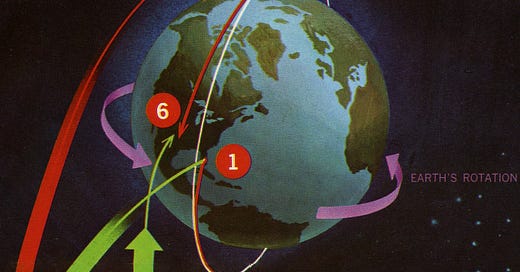


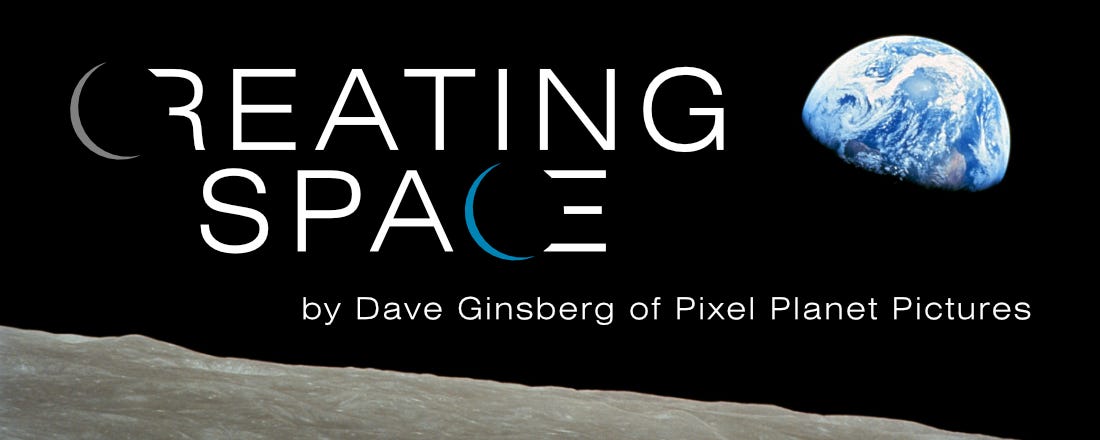
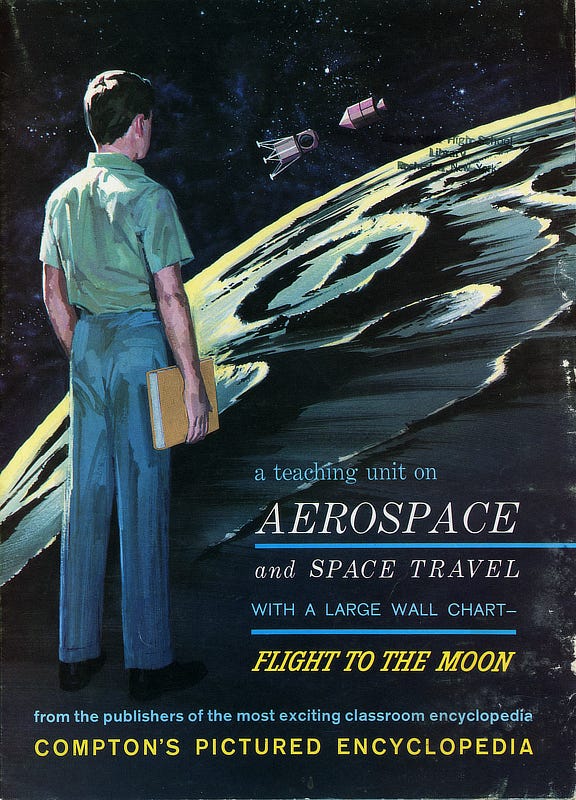
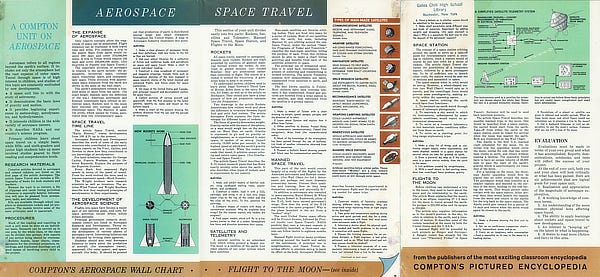
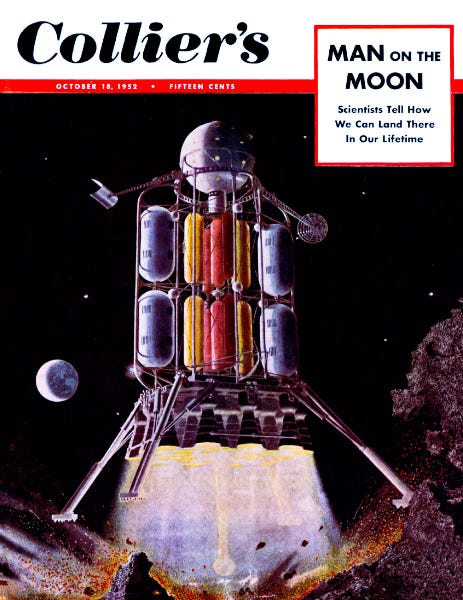

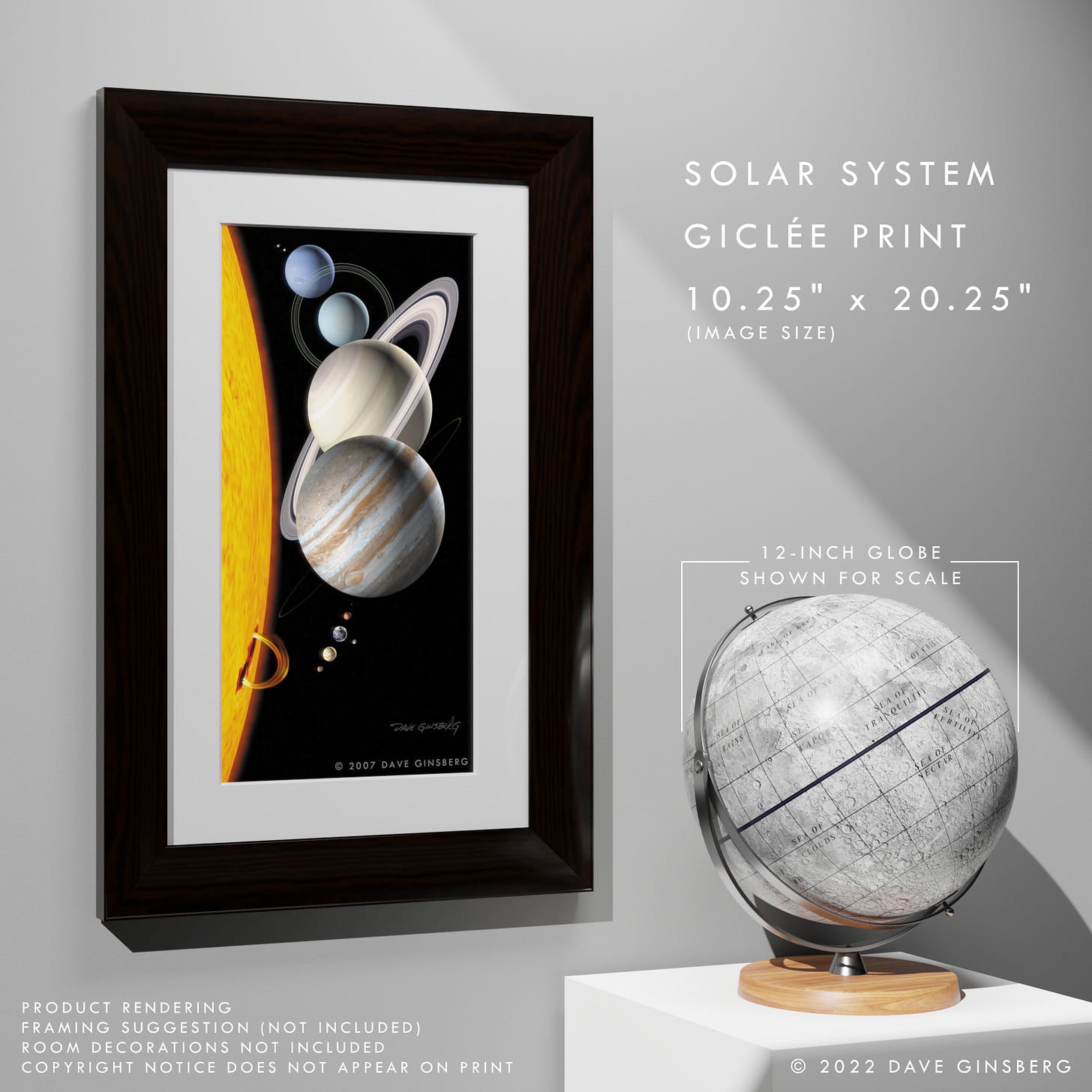





Once again an excellent article Dave. A fun look at the books that inspired a generation, and an excellent addition to your library. I've been building a library with similar books for my grandchildren. Hopefully these will inspire them to pursue careers that reach beyond our planet and/or solar system.